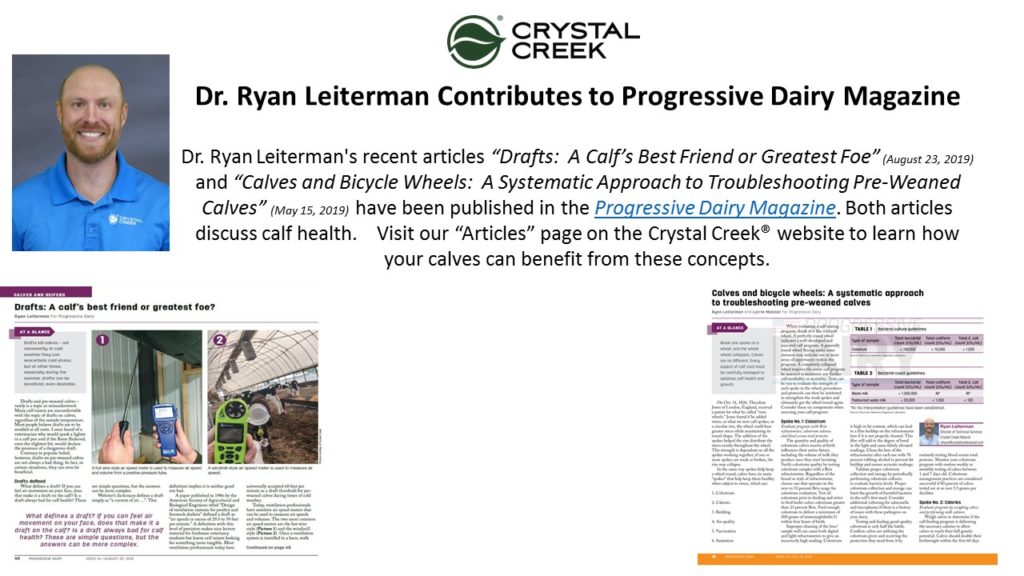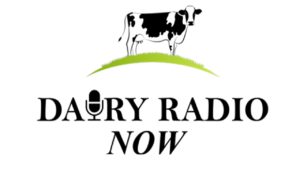Visit Crystal Creek at World Dairy Expo 2019
Visit Crystal Creek® at World Dairy Expo in Trade Center Booth # 893. October 1st through October 5th, 2019. Check here for a daily schedule of events: https://worlddairyexpo.com/pages/Daily-Schedule.php or stop by our office headquarters in Spooner, WI where you can pick up a brochure containing the daily schedule before the show. Expo provides an excellent opportunity to learn about new products, exciting developments in innovation, and network with existing and new industry professionals. Crystal Creek® will have nutrition and calf barn ventilation specialists on hand at their booth daily to answer your questions. We look forward to seeing you at World Dairy Expo 2019!
Dr. Ryan Leiterman Contributes to Progressive Dairy Magazine
Dr. Ryan Leiterman’s recent article “Drafts: A Calf’s Best Friend or Greatest Foe” has been published in the Progressive Dairy Magazine.  This article addresses why drafts are traditionally thought of as a negative experience for calves and how they can be used to one’s advantage in certain situations. Read more here to learn what the pros and cons of drafts can be in calf barn ventilation.
This article addresses why drafts are traditionally thought of as a negative experience for calves and how they can be used to one’s advantage in certain situations. Read more here to learn what the pros and cons of drafts can be in calf barn ventilation.
Click here to view as a pdf: A calf’s best friend or greatest foe
By Dr. Ryan Leiterman
Drafts and pre-weaned calves – rarely is a topic so misunderstood. Many calf raisers are uncomfortable with the topic of drafts on calves, regardless of the outside temperature. Most people believe drafts are to be avoided at all costs. I once heard of a veterinarian who would spark a lighter in a calf pen and if the flame flickered, even the slightest bit, would declare the presence of a dangerous draft. Contrary to popular belief, however, drafts on pre-weaned calves are not always a bad thing. In fact, in certain situations, they can even be beneficial.
Dairy Radio Now: “ASK THE VET”
 Dr. Ryan Leiterman, Director of Technical Services for Crystal Creek®, is pleased to be a regular contributor to the Dairy Radio Now program with host, Bill Baker. Dr. Leiterman will speak on topics relevant to the dairy calf industry in a featured segment called “Ask the Vet“. Visit Dairy Radio Now at https://dairyradio.com/
Dr. Ryan Leiterman, Director of Technical Services for Crystal Creek®, is pleased to be a regular contributor to the Dairy Radio Now program with host, Bill Baker. Dr. Leiterman will speak on topics relevant to the dairy calf industry in a featured segment called “Ask the Vet“. Visit Dairy Radio Now at https://dairyradio.com/
This segment is heard on Dairy Radio Now the first Wednesday of every month.
EMAIL YOUR QUESTIONS TO askthevet@crystalcreeknatural.com
5/8/2024: ASK THE VET: Calf Barn Drawing Technology
4/2/2024: ASK THE VET: Dairy Milk Pricing Part 2
3/5/2024: ASK THE VET: Dairy Milk Pricing
2/7/2024: ASK THE VET: The Highs and Lows of Winter Temperatures
10/5/2023: ASK THE VET: Calves Are Amazing
8/7/2023: ASK THE VET: The Heat is On- Keep Calves Cool
5/4/2023: ASK THE VET: Mastitis Cases Expected To Rise During Summer Months
4/6/2023: ASK THE VET: The Skin Is A Window To The Immune System
3/2/2023: ASK THE VET: Strange Vet Visits
2/1/2023: ASK THE VET: Calf Friendly Feeding
1/5/2023: ASK THE VET: Feeding Young Calves More Frequently
12/09/2022: ASK THE VET: The Physiology of Feeding Calves
11/02/2022: ASK THE VET: Feeding Fiber Over Starch
10/06/2022: ASK THE VET: Dealing with High Corn Prices
9/07/2022: ASK THE VET: Calf Diarrhea: Two Causes, Two Strategies
8/03/2022: ASK THE VET: The Science Behind Heat Stress
7/06/2022: ASK THE VET: Keeping Cows Cool
6/01/2022: ASK THE VET: Taking Care of Man’s Best Friend
5/04/2022: ASK THE VET: Improving Rumen Microbial Growth
4/07/2022: ASK THE VET: Mixing Milk Replacer: A Daily Task
3/02/2022: ASK THE VET: Calf Feeding Programs Vary
2/02/2022: ASK THE VET: The Importance of Calf Milk Replacer
1/05/2022: ASK THE VET: Keeping Fans on During Winter
12/01/2021: ASK THE VET: Dairying in Northern Italy
11/03/2021: ASK THE VET: Tweaking the Dairy Ration
10/06/2021: ASK THE VET: Calf Care During Seasonal Changes
09/01/2021: ASK THE VET: Gleaning Information from Forage Fermentation Profiles
08/11/2021: ASK THE VET: Forage Program Begins with Fermentation Profile
07/07/2021: ASK THE VET: Home Grown Forage Digestibility
06/02/2021: ASK THE VET: Tweaking the Dairy Ration
05/06/2021: ASK THE VET: As the Skin Goes, the Immune System Goes
04/07/2021: ASK THE VET: Skin Condition Relates to the Immune System
3/02/2021: ASK THE VET: Keeping Water Safe and Clean
2/03/2021: ASK THE VET: Biofilm Awareness
1/06/2021: ASK THE VET: Understanding Winter Ventilation
12/03/2020: ASK THE VET: Minimizing the Risk of Ketosis
11/04/2020: ASK THE VET: Ketosis Testing & Treatment Options
10/07/2020: ASK THE VET: Testing for Ketosis
09/02/2020: ASK THE VET: Calf Diarrhea is Cause for Concern
08/04/2020: ASK THE VET: The Heat Is On
07/01/2020: ASK THE VET: Why Vaccines Fail-Part 2
06/03/2020: ASK THE VET: Knowing Your Calf Vaccines-Part 1
05/06/2020: ASK THE VET: Tips for Feeding Calves
04/01/2020: ASK THE VET: Biofilms in Agriculture
03/04/2020: ASK THE VET: Spring Cleaning with Results
02/05/2020: ASK THE VET: Feeding Young Calves
01/02/2020: Heat and Winter Barn Ventilation
12/4/19: Winter Barn Ventilation Tips
11/6/19: Don’t Limit Winter Barn Circulation
10/2/19: ‘Tis The Season to Control Air Flow
9/5/19: Six ‘Spokes’ to Calf Health
8/7/19: Beat the Heat with Proper Ventilation
7/3/19: Dairying in Russia
6/5/19: Observations From Europe
5/1/19: German Farming Practices
August 2019 Newsletter
Click here to view as a pdf: 2019 August Newsletter
A New Generation Of Mycotoxin Technology
Click here to view as a pdf: A New Generation Of Mycotoxin Technology

By Dan Leiterman
In my April 2016 newsletter article “Managing Mycotoxins In Feedstuffs: Mycotoxin Binder Strategies”, I explained the significant negative effects mycotoxins have on livestock health and production. That article pointed out the previous challenges of inaccurate lab analysis of mycotoxins, how to interpret a lab analysis to determine a management plan for a given level of exposure and the subsequent limitations of strategies available at the time. This article can be found on our website under the “Articles” tab, under the sub-category of “Inoculant.”
Milk Or Profit: A Case Study
Click here to view as a pdf: Milk Or Profit A Case Study
 By Erik Brettingen, B.S.
By Erik Brettingen, B.S.
Rolling herd average or milk production per cow are numbers commonly referred to when discussing the success of a dairy farm. Milk production is an easy number to identify but the actual profitability of an operation is a much more complex topic. A dairy herd’s income is simple to see by reading the milk check. Determining the real profit of the herd cannot be so easily evaluated as it takes time to assess the expenses involved in making the milk and running the operation.
How To Determine The Value Of Whole Leaf Aloe Vera For Your Livestock
Click here to view as a pdf: How To Determine The Value Of Whole Leaf Aloe Vera For Your Livestock
By Teresa Marker, B.S.
Stress is defined as a state of strain from adverse or demanding conditions. Livestock can be stressed by many different factors: weaning, pen movement, dehorning, vaccinating, shipping, lactation, weather, flies, etc. Some of these stressors can be reduced by good management, but not all stressors can be eliminated. The immune system of an animal has the ability to resist infection or disease. However, when animals are stressed, they are more vulnerable to disease due to decreased immune function.
Heat Stress In Poultry
Click here to view as a pdf: Heat Stress In Poultry
By Stephanie Hutsko, PhD
Simply put, heat stress occurs when a bird’s core temperature is higher than its thermoneutral zone (Figure 1). A thermoneutral zone is a temperature range in which an animal does not use any additional energy to maintain its normal core body temperature. Heat stress is a result of a negative balance between the energy transfer from the bird’s body to its environment and the amount of heat energy produced by the bird. This imbalance can be caused by multiple factors such as ambient temperature, humidity, air movement, metabolism rate and thermal irradiation. Effects can range from mild distress to death.
Maximizing Your Cover Crop Potential
Click here to view as a pdf: Maximizing Your Cover Crop Potential
There are many benefits of incorporating a cover crop into crop rotations. Clearly identifying crop needs and goals will aid in proper plant species selection.
This article will discuss four basic goals of cover crops; protecting soil from erosion, grazing and harvesting of forage, improving soil health and weed suppression.





